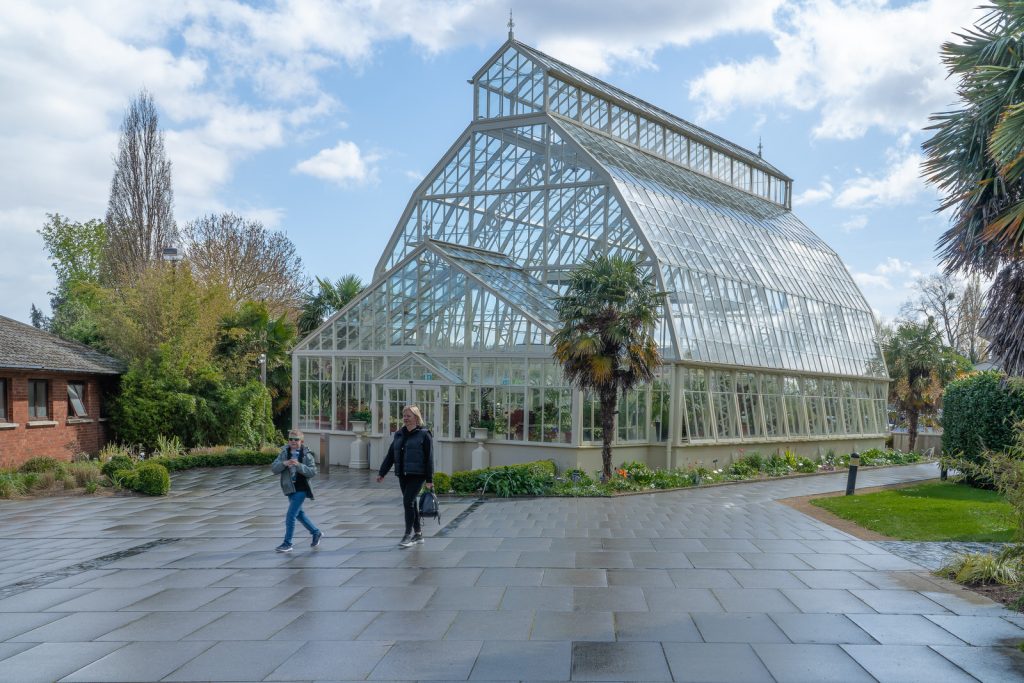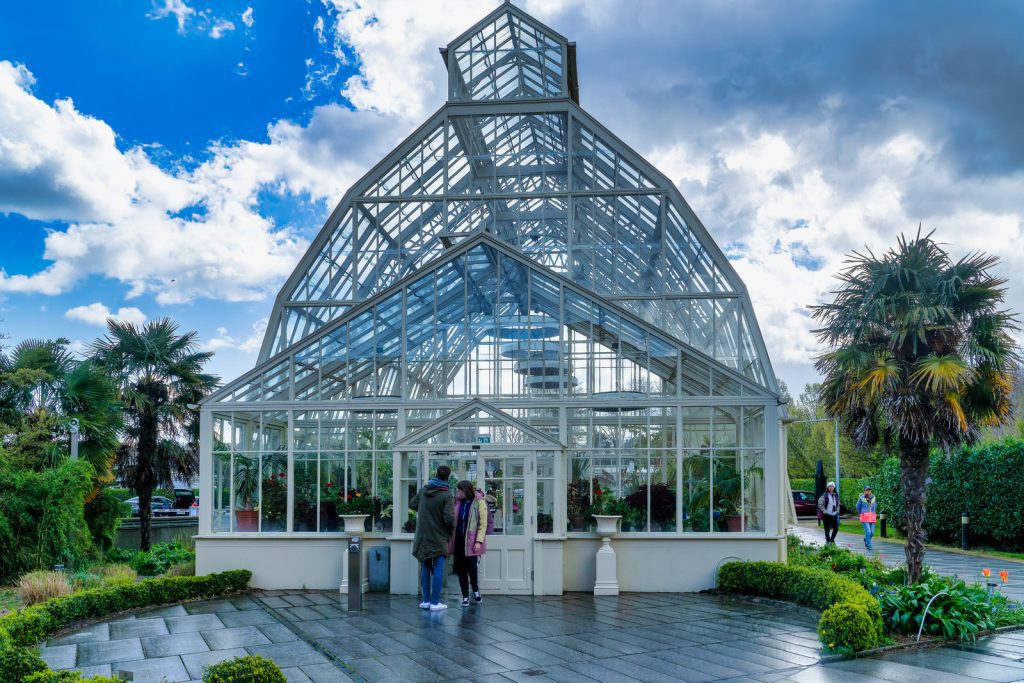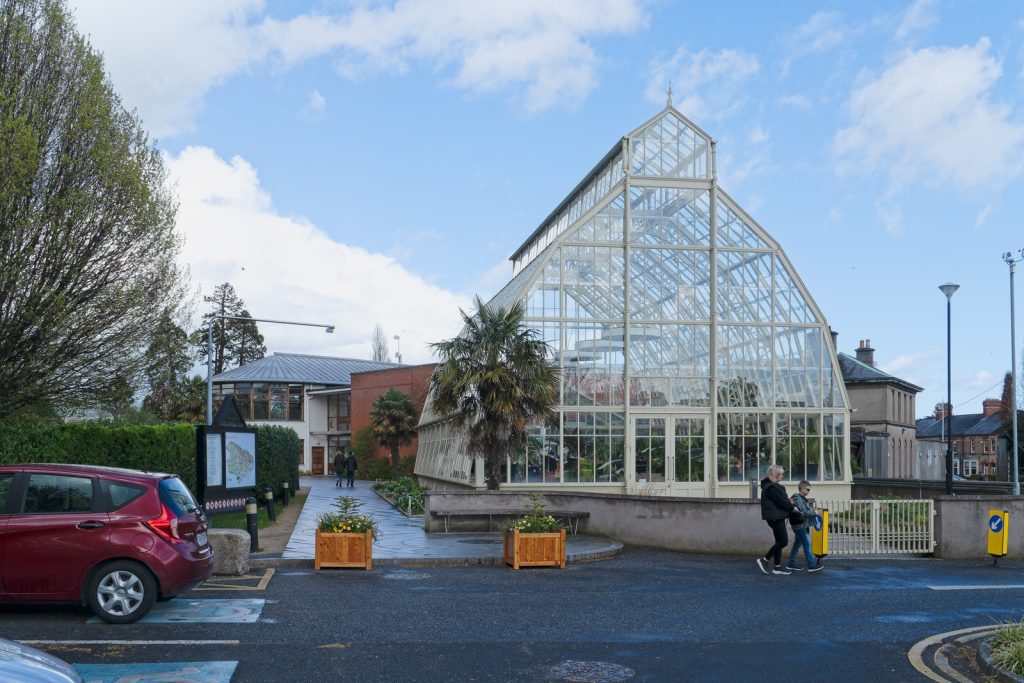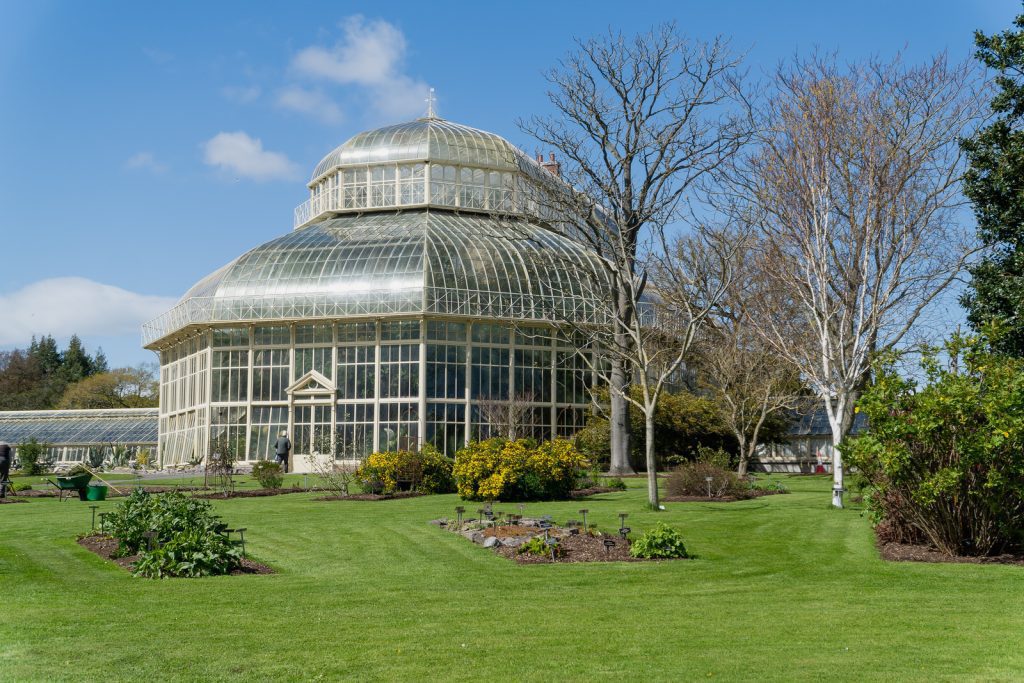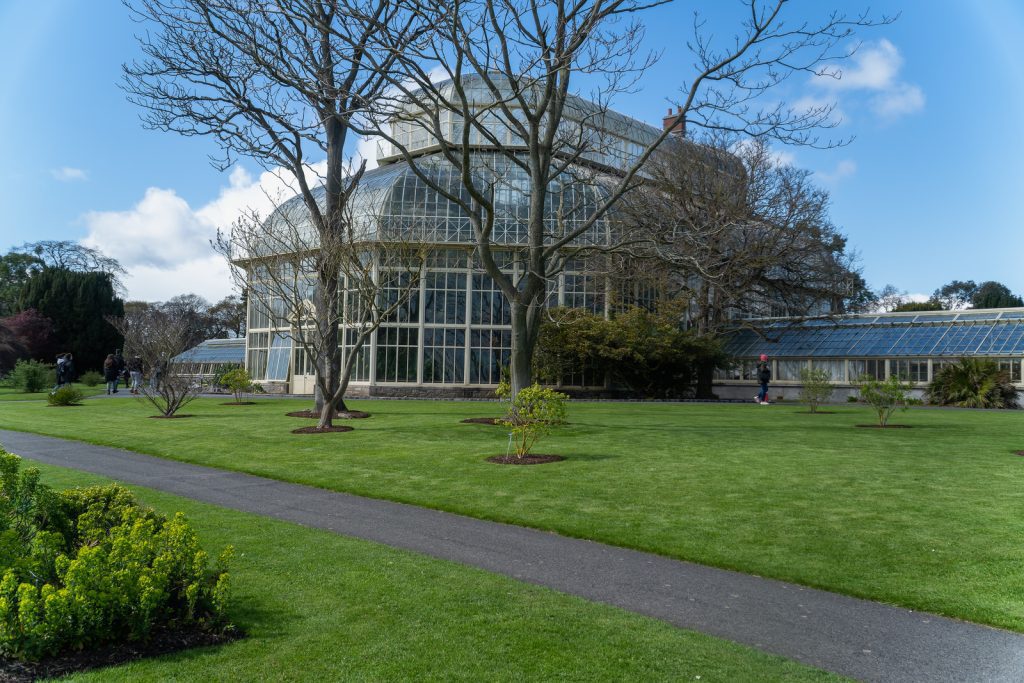TODAY I USED A SONY FE 16-35MM F2.8 GM II LENS
Today I visited the Botanic Gardens in Dublin and at the end of May 2025 I hope to visit the Botanic Gardens in Belfast.
The National Botanic Gardens in Dublin, located in Glasnevin, boast a remarkable collection of beautifully restored and historically significant glasshouses. These structures are not only functional spaces for cultivating diverse plant collections but also represent significant achievements in Victorian engineering and design.
The most notable glasshouses in Dublin include:
The Curvilinear Range: Designed and largely constructed by the celebrated Dublin ironmaster Richard Turner and his son, this long, low range of iron and glass with its distinctive curved roof was built in stages from the 1840s. It’s considered one of the most important buildings in the Gardens and a fine example of Turner’s innovative style. Its central dome was once featured on Irish stamps.
The Great Palm House: Erected in 1884 to replace an earlier structure damaged by a storm, the ironwork for this impressive house was fabricated in Glasgow. Faithfully restored in the early 2000s, it is the tallest structure in the Gardens and houses a diverse collection of tropical plants.
The Orchid House: Reflecting the historical importance of orchid cultivation in Glasnevin (where orchids were first grown to flowering stage from seed in Ireland in the 1840s), this house was restored alongside the Palm House.
The Victoria Waterlily House: Designed and built in 1854, this house was specifically created to display the then-botanical sensation, Victoria amazonica, the giant Amazon waterlily.
The Alpine House: Home to a collection of plants from mountainous regions around the world.
The Cactus and Succulent House: Currently housing the cactus and succulent collection while their original house undergoes restoration.
The Teak House: A later addition, known for hosting the annual Orchid Fair.
Many of these glasshouses, particularly the Turner Curvilinear Range and the Great Palm House, have received Europa Nostra awards for their excellence in conservation architecture. They are open to the public free of charge throughout the year, except on Christmas Day.
In contrast, the Botanic Gardens in Belfast also feature significant Victorian glasshouses, most notably:
The Palm House: Designed by Charles Lanyon and with wrought iron construction by Richard Turner, this Palm House was completed in 1840, predating Turner’s work in Dublin and Kew Gardens. It is one of the earliest examples of a curvilinear cast iron glasshouse and is divided into three sections: a cool wing, a tropical wing, and a central dome for taller palms.
The Tropical Ravine House: Built in 1889 by the head gardener Charles McKimm, this glasshouse has a unique sunken ravine running its length with viewing balconies on either side. It houses a collection of tropical plants, some of which are very old and endangered.
Comparing and Contrasting the Glasshouses:
Both the Dublin and Belfast Botanic Gardens boast impressive Victorian glasshouses that are significant for their architectural merit and the plant collections they house. Richard Turner played a key role in the construction of significant glasshouses in both cities, highlighting his importance as a leading ironmaster and glasshouse designer of the era.
However, there are some differences:
Number and Variety: Dublin has a larger number and a greater variety of distinct glasshouses, each often dedicated to specific plant groups or climates (e.g., Alpine House, Cactus and Succulent House, Orchid House, Victoria Waterlily House). Belfast’s main historical glasshouses are the Palm House and the Tropical Ravine.
Design and Layout: While both feature curvilinear designs characteristic of the Victorian era, the Tropical Ravine in Belfast offers a unique sunken layout not found in Dublin. Dublin’s Curvilinear Range is a long, linear structure with a central dome, whereas Belfast’s Palm House has a more traditional dome structure with flanking wings.
Historical Significance: Both Palm Houses are early and important examples of Victorian glasshouse construction. Belfast’s Palm House predates Dublin’s major Turner structures. The Tropical Ravine in Belfast is also a unique example of Victorian horticultural architecture. Dublin’s glasshouses, particularly the Curvilinear Range, are notable for their association with Richard Turner’s distinct style and the historical cultivation of orchids.
Restoration: Both gardens have undertaken significant restoration work on their historic glasshouses to preserve these important structures for future generations.
In conclusion, both the National Botanic Gardens in Dublin and the Botanic Gardens in Belfast are home to significant and beautiful Victorian glasshouses that reflect the horticultural and architectural achievements of their time. While both share a connection through the work of Richard Turner, they each possess unique characteristics in terms of the number, design, and layout of their glasshouse collections.
![THE GLASSHOUSES IN THE BOTANIC GARDENS IN DUBLIN [3 MAY 2025]-250341-1](https://excellentstreetimages.com/ParksAndGardensWordPress/wp-content/uploads/2025/05/THE-GLASSHOUSES-IN-THE-BOTANIC-GARDENS-IN-DUBLIN-3-MAY-2025-250341-1-1422x1067.jpg)
![THE GLASSHOUSES IN THE BOTANIC GARDENS IN DUBLIN [3 MAY 2025]-250340-1](https://excellentstreetimages.com/ParksAndGardensWordPress/wp-content/uploads/2025/05/THE-GLASSHOUSES-IN-THE-BOTANIC-GARDENS-IN-DUBLIN-3-MAY-2025-250340-1-1422x1067.jpg)
![THE GLASSHOUSES IN THE BOTANIC GARDENS IN DUBLIN [3 MAY 2025]-250339-1](https://excellentstreetimages.com/ParksAndGardensWordPress/wp-content/uploads/2025/05/THE-GLASSHOUSES-IN-THE-BOTANIC-GARDENS-IN-DUBLIN-3-MAY-2025-250339-1-1422x1067.jpg)
![THE GLASSHOUSES IN THE BOTANIC GARDENS IN DUBLIN [3 MAY 2025]-250337-1](https://excellentstreetimages.com/ParksAndGardensWordPress/wp-content/uploads/2025/05/THE-GLASSHOUSES-IN-THE-BOTANIC-GARDENS-IN-DUBLIN-3-MAY-2025-250337-1-1422x1067.jpg)
![THE GLASSHOUSES IN THE BOTANIC GARDENS IN DUBLIN [3 MAY 2025]-250338-1](https://excellentstreetimages.com/ParksAndGardensWordPress/wp-content/uploads/2025/05/THE-GLASSHOUSES-IN-THE-BOTANIC-GARDENS-IN-DUBLIN-3-MAY-2025-250338-1-1422x1067.jpg)
![THE GLASSHOUSES IN THE BOTANIC GARDENS IN DUBLIN [3 MAY 2025]-250336-1](https://excellentstreetimages.com/ParksAndGardensWordPress/wp-content/uploads/2025/05/THE-GLASSHOUSES-IN-THE-BOTANIC-GARDENS-IN-DUBLIN-3-MAY-2025-250336-1-1422x1067.jpg)
![THE GLASSHOUSES IN THE BOTANIC GARDENS IN DUBLIN [3 MAY 2025]-250335-1](https://excellentstreetimages.com/ParksAndGardensWordPress/wp-content/uploads/2025/05/THE-GLASSHOUSES-IN-THE-BOTANIC-GARDENS-IN-DUBLIN-3-MAY-2025-250335-1-1422x1067.jpg)
![THE GLASSHOUSES IN THE BOTANIC GARDENS IN DUBLIN [3 MAY 2025]-250334-1](https://excellentstreetimages.com/ParksAndGardensWordPress/wp-content/uploads/2025/05/THE-GLASSHOUSES-IN-THE-BOTANIC-GARDENS-IN-DUBLIN-3-MAY-2025-250334-1-1422x1067.jpg)
![THE GLASSHOUSES IN THE BOTANIC GARDENS IN DUBLIN [3 MAY 2025]-250333-1](https://excellentstreetimages.com/ParksAndGardensWordPress/wp-content/uploads/2025/05/THE-GLASSHOUSES-IN-THE-BOTANIC-GARDENS-IN-DUBLIN-3-MAY-2025-250333-1-1422x1067.jpg)
![THE GLASSHOUSES IN THE BOTANIC GARDENS IN DUBLIN [3 MAY 2025]-250332-1](https://excellentstreetimages.com/ParksAndGardensWordPress/wp-content/uploads/2025/05/THE-GLASSHOUSES-IN-THE-BOTANIC-GARDENS-IN-DUBLIN-3-MAY-2025-250332-1-1422x1067.jpg)
![THE GLASSHOUSES IN THE BOTANIC GARDENS IN DUBLIN [3 MAY 2025]-250331-1](https://excellentstreetimages.com/ParksAndGardensWordPress/wp-content/uploads/2025/05/THE-GLASSHOUSES-IN-THE-BOTANIC-GARDENS-IN-DUBLIN-3-MAY-2025-250331-1-1422x1067.jpg)
![THE GLASSHOUSES IN THE BOTANIC GARDENS IN DUBLIN [3 MAY 2025]-250330-1](https://excellentstreetimages.com/ParksAndGardensWordPress/wp-content/uploads/2025/05/THE-GLASSHOUSES-IN-THE-BOTANIC-GARDENS-IN-DUBLIN-3-MAY-2025-250330-1-1422x1067.jpg)
![THE GLASSHOUSES IN THE BOTANIC GARDENS IN DUBLIN [3 MAY 2025]-250329-1](https://excellentstreetimages.com/ParksAndGardensWordPress/wp-content/uploads/2025/05/THE-GLASSHOUSES-IN-THE-BOTANIC-GARDENS-IN-DUBLIN-3-MAY-2025-250329-1-1422x1067.jpg)
![THE GLASSHOUSES IN THE BOTANIC GARDENS IN DUBLIN [3 MAY 2025]-250327-1](https://excellentstreetimages.com/ParksAndGardensWordPress/wp-content/uploads/2025/05/THE-GLASSHOUSES-IN-THE-BOTANIC-GARDENS-IN-DUBLIN-3-MAY-2025-250327-1-1422x1067.jpg)
![THE GLASSHOUSES IN THE BOTANIC GARDENS IN DUBLIN [3 MAY 2025]-250328-1](https://excellentstreetimages.com/ParksAndGardensWordPress/wp-content/uploads/2025/05/THE-GLASSHOUSES-IN-THE-BOTANIC-GARDENS-IN-DUBLIN-3-MAY-2025-250328-1-1422x1067.jpg)
![THE GLASSHOUSES IN THE BOTANIC GARDENS IN DUBLIN [3 MAY 2025]-250325-1](https://excellentstreetimages.com/ParksAndGardensWordPress/wp-content/uploads/2025/05/THE-GLASSHOUSES-IN-THE-BOTANIC-GARDENS-IN-DUBLIN-3-MAY-2025-250325-1-1422x1067.jpg)
![THE GLASSHOUSES IN THE BOTANIC GARDENS IN DUBLIN [3 MAY 2025]-250326-1](https://excellentstreetimages.com/ParksAndGardensWordPress/wp-content/uploads/2025/05/THE-GLASSHOUSES-IN-THE-BOTANIC-GARDENS-IN-DUBLIN-3-MAY-2025-250326-1-1422x1067.jpg)
![THE GLASSHOUSES IN THE BOTANIC GARDENS IN DUBLIN [3 MAY 2025]-250324-1](https://excellentstreetimages.com/ParksAndGardensWordPress/wp-content/uploads/2025/05/THE-GLASSHOUSES-IN-THE-BOTANIC-GARDENS-IN-DUBLIN-3-MAY-2025-250324-1-1422x1067.jpg)
![THE GLASSHOUSES IN THE BOTANIC GARDENS IN DUBLIN [3 MAY 2025]-250323-1](https://excellentstreetimages.com/ParksAndGardensWordPress/wp-content/uploads/2025/05/THE-GLASSHOUSES-IN-THE-BOTANIC-GARDENS-IN-DUBLIN-3-MAY-2025-250323-1-1422x1067.jpg)
![THE GLASSHOUSES IN THE BOTANIC GARDENS IN DUBLIN [3 MAY 2025]-250321-1](https://excellentstreetimages.com/ParksAndGardensWordPress/wp-content/uploads/2025/05/THE-GLASSHOUSES-IN-THE-BOTANIC-GARDENS-IN-DUBLIN-3-MAY-2025-250321-1-1422x1067.jpg)
![THE GLASSHOUSES IN THE BOTANIC GARDENS IN DUBLIN [3 MAY 2025]-250320-1](https://excellentstreetimages.com/ParksAndGardensWordPress/wp-content/uploads/2025/05/THE-GLASSHOUSES-IN-THE-BOTANIC-GARDENS-IN-DUBLIN-3-MAY-2025-250320-1-1422x1067.jpg)
![THE GLASSHOUSES IN THE BOTANIC GARDENS IN DUBLIN [3 MAY 2025]-250322-1](https://excellentstreetimages.com/ParksAndGardensWordPress/wp-content/uploads/2025/05/THE-GLASSHOUSES-IN-THE-BOTANIC-GARDENS-IN-DUBLIN-3-MAY-2025-250322-1-1422x1067.jpg)
![THE GLASSHOUSES IN THE BOTANIC GARDENS IN DUBLIN [3 MAY 2025]-250319-1](https://excellentstreetimages.com/ParksAndGardensWordPress/wp-content/uploads/2025/05/THE-GLASSHOUSES-IN-THE-BOTANIC-GARDENS-IN-DUBLIN-3-MAY-2025-250319-1-1422x1067.jpg)
![THE GLASSHOUSES IN THE BOTANIC GARDENS IN DUBLIN [3 MAY 2025]-250317-1](https://excellentstreetimages.com/ParksAndGardensWordPress/wp-content/uploads/2025/05/THE-GLASSHOUSES-IN-THE-BOTANIC-GARDENS-IN-DUBLIN-3-MAY-2025-250317-1-1422x1067.jpg)
![THE GLASSHOUSES IN THE BOTANIC GARDENS IN DUBLIN [3 MAY 2025]-250316-1](https://excellentstreetimages.com/ParksAndGardensWordPress/wp-content/uploads/2025/05/THE-GLASSHOUSES-IN-THE-BOTANIC-GARDENS-IN-DUBLIN-3-MAY-2025-250316-1-1422x1067.jpg)
![THE GLASSHOUSES IN THE BOTANIC GARDENS IN DUBLIN [3 MAY 2025]-250318-1](https://excellentstreetimages.com/ParksAndGardensWordPress/wp-content/uploads/2025/05/THE-GLASSHOUSES-IN-THE-BOTANIC-GARDENS-IN-DUBLIN-3-MAY-2025-250318-1-1422x1067.jpg)
![THE GLASSHOUSES IN THE BOTANIC GARDENS IN DUBLIN [3 MAY 2025]-250315-1](https://excellentstreetimages.com/ParksAndGardensWordPress/wp-content/uploads/2025/05/THE-GLASSHOUSES-IN-THE-BOTANIC-GARDENS-IN-DUBLIN-3-MAY-2025-250315-1-1422x1067.jpg)
![THE GLASSHOUSES IN THE BOTANIC GARDENS IN DUBLIN [3 MAY 2025]-250314-1](https://excellentstreetimages.com/ParksAndGardensWordPress/wp-content/uploads/2025/05/THE-GLASSHOUSES-IN-THE-BOTANIC-GARDENS-IN-DUBLIN-3-MAY-2025-250314-1-1422x1067.jpg)
![THE GLASSHOUSES IN THE BOTANIC GARDENS IN DUBLIN [3 MAY 2025]-250313-1](https://excellentstreetimages.com/ParksAndGardensWordPress/wp-content/uploads/2025/05/THE-GLASSHOUSES-IN-THE-BOTANIC-GARDENS-IN-DUBLIN-3-MAY-2025-250313-1-1422x1067.jpg)
![THE GLASSHOUSES IN THE BOTANIC GARDENS IN DUBLIN [3 MAY 2025]-250312-1](https://excellentstreetimages.com/ParksAndGardensWordPress/wp-content/uploads/2025/05/THE-GLASSHOUSES-IN-THE-BOTANIC-GARDENS-IN-DUBLIN-3-MAY-2025-250312-1-1422x1067.jpg)
![THE SMALL FOOTBRIDGE [ACROSS THE LILY POND AT THE BOTANIC GARDENS]-219049-1 THE SMALL FOOTBRIDGE [ACROSS THE LILY POND AT THE BOTANIC GARDENS] 005](https://excellentstreetimages.com/ParksAndGardensWordPress/wp-content/uploads/2023/06/THE-SMALL-FOOTBRIDGE-ACROSS-THE-LILY-POND-AT-THE-BOTANIC-GARDENS-219049-1-1422x1067.jpg)
![THE SMALL FOOTBRIDGE [ACROSS THE LILY POND AT THE BOTANIC GARDENS]-219048-1 THE SMALL FOOTBRIDGE [ACROSS THE LILY POND AT THE BOTANIC GARDENS] 004](https://excellentstreetimages.com/ParksAndGardensWordPress/wp-content/uploads/2023/06/THE-SMALL-FOOTBRIDGE-ACROSS-THE-LILY-POND-AT-THE-BOTANIC-GARDENS-219048-1-1422x1067.jpg)
![THE SMALL FOOTBRIDGE [ACROSS THE LILY POND AT THE BOTANIC GARDENS]-219047-1 THE SMALL FOOTBRIDGE [ACROSS THE LILY POND AT THE BOTANIC GARDENS] 003](https://excellentstreetimages.com/ParksAndGardensWordPress/wp-content/uploads/2023/06/THE-SMALL-FOOTBRIDGE-ACROSS-THE-LILY-POND-AT-THE-BOTANIC-GARDENS-219047-1-1422x1067.jpg)
![THE SMALL FOOTBRIDGE [ACROSS THE LILY POND AT THE BOTANIC GARDENS]-219046-1 THE SMALL FOOTBRIDGE [ACROSS THE LILY POND AT THE BOTANIC GARDENS] 002](https://excellentstreetimages.com/ParksAndGardensWordPress/wp-content/uploads/2023/06/THE-SMALL-FOOTBRIDGE-ACROSS-THE-LILY-POND-AT-THE-BOTANIC-GARDENS-219046-1-1422x1067.jpg)
![THE SMALL FOOTBRIDGE [ACROSS THE LILY POND AT THE BOTANIC GARDENS]-219045-1 THE SMALL FOOTBRIDGE [ACROSS THE LILY POND AT THE BOTANIC GARDENS] 001](https://excellentstreetimages.com/ParksAndGardensWordPress/wp-content/uploads/2023/06/THE-SMALL-FOOTBRIDGE-ACROSS-THE-LILY-POND-AT-THE-BOTANIC-GARDENS-219045-1-1396x1047.jpg)
